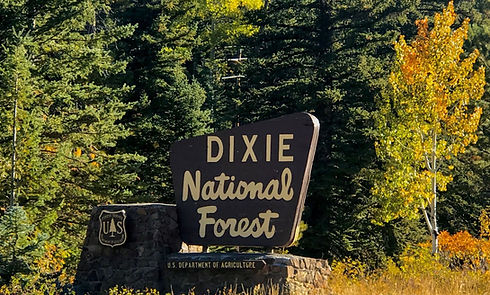Dixie National Forest

Planting in this forest.
Dixie National Forest, encompassing over 2 million acres in southern Utah, is a vast and ecologically rich wilderness. Its landscapes span from the arid deserts of the Great Basin to the alpine heights of Boulder Mountain, creating an intricate tapestry of habitats that support diverse plant and animal life. However, the forest has faced significant environmental challenges over the years, including damage from bark beetle infestations and catastrophic wildfires. Restoration efforts, such as the Engelmann Spruce Replanting project, have played a vital role in preserving the forest’s ecological integrity.
The Engelmann Spruce Replanting project, launched in 2020, was a response to the devastating spruce beetle outbreaks that decimated Engelmann spruce populations in the early 2000s. These outbreaks left large areas of the forest vulnerable, disrupting habitats and increasing the risk of soil erosion. To address this, over 19,250 Engelmann spruce seedlings were planted across 92 acres, carefully chosen for their ability to thrive in the high-elevation conditions of Dixie National Forest. Volunteers and forestry teams worked tirelessly to transport and plant the seedlings, ensuring proper placement and care. The project achieved an impressive survival rate, reflecting the effectiveness of these efforts. In the fall of 2024, additional spruce trees were planted to further expand the forest’s recovery, reinforcing its role as a crucial habitat for wildlife and a natural barrier against the impacts of climate change.
In addition to the spruce replanting efforts, Dixie National Forest has undergone significant recovery work following the 2017 Brian Head Fire, which burned over 71,000 acres. The aftermath of the fire left the land vulnerable to erosion, invasive species, and habitat loss. Restoration focused on reintroducing native vegetation, stabilizing the soil, and planting species such as ponderosa pine and aspen to rebuild the forest’s biodiversity. These efforts, combined with the Engelmann spruce project, underscore a strong commitment to regenerating this vital landscape.
Dixie National Forest supports a remarkable array of flora and fauna. Lower elevations are characterized by towering ponderosa pines and Douglas firs, while higher altitudes are home to Engelmann spruce and aspen groves. The forest is also renowned for its bristlecone pines, some of the oldest living trees on Earth, found in remote and protected areas. This vegetation creates essential habitats for numerous species. Large mammals like mule deer and elk roam the forest, foraging on its abundant foliage, while black bears search for berries and other food sources. Cougars, stealthy and powerful predators, patrol their territories, while smaller mammals such as marmots and red foxes scurry across the forest floor. River otters thrive in the forest’s waterways, which are crucial for maintaining aquatic biodiversity.
The birdlife of Dixie National Forest further enriches its ecosystem. Red-tailed hawks glide above the treetops, and great horned owls find shelter in its branches. Western tanagers, with their striking yellow and red plumage, are frequent visitors during the warmer months, adding vibrant splashes of color to the forest. Wetland areas host great blue herons and belted kingfishers, while songbirds like the mountain bluebird flit between shrubs, their calls adding to the forest’s serene atmosphere.
Beyond its ecological importance, Dixie National Forest offers stunning natural features that captivate visitors. Its elevation ranges up to 11,000 feet on Boulder Mountain, providing breathtaking views of desert plateaus, alpine meadows, and rugged peaks. The forest’s bristlecone pines, ancient and awe-inspiring, are a particular highlight. These landscapes, combined with its rich biodiversity, make Dixie National Forest a treasured gem of the Southwest.




Location
Utah, USA
Project Type
Reforestation
Environmental Benefits
Wildfire Restoration
Erosion Prevention
Habitat Restoration
Biodiversity Enhancement
Increased Carbon Capture
About this forest
Dixie National Forest, Utah’s largest national forest, spans mountains and plateaus with diverse climates. Home to Engelmann spruce and high-altitude ecosystems, the forest supports unique wildlife, such as cougars and eagles. Replanting here will benefit soil stability, wildlife, and carbon capture.




